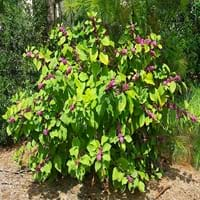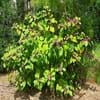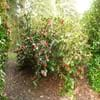What is
Life Span
Perennial
Perennial
Type
Shrub
Fruit
Origin
Southeastern United States, South-Central United States
Mexico, Central America
Types
Not Available
Reinikie, Dade, Pike, Suebelle and Golden
Climate
Number of Varieties
Not Available
5
99+
Habitat
bottomlands, Coastal Regions, Moist woods, pine woods, Slopes, Swamps, Thickets, Woods
Tropical Highlands
USDA Hardiness Zone
6-11
8-11
AHS Heat Zone
12-1
11-6
Sunset Zone
3a, 3b, 4, 5, 6, 7, 8, 9, 14, 15, 16, 17, 18, 19, 20, 21, 22, 23, 24
H1, H2, 14, 15, 16, 17, 18, 19, 20, 21, 22, 23, 24
Habit
Arching/Fountain-shaped
Oval or Rounded
Information
Plant Size
Minimum Height
182.88 cm
99+
610.00 cm
99+
Minimum Width
182.88 cm
99+
760.00 cm
29
Plant Color
Flower Color
Pink, Lavender
Light Green, Ivory
Flower Color Modifier
Not Available
Bicolor
Fruit Color
Purple, White
Light Yellow, Yellow green, Light Green
Leaf Color in Spring
Light Green
Green, Dark Green
Leaf Color in Summer
Light Green
Green, Dark Green
Leaf Color in Fall
Yellow green, Tan
Green, Dark Green
Leaf Color in Winter
Not Available
Light Green
Shape
Leaf Shape
Elliptic
Alternate
Thorns
No
No
Season
Plant Season
Spring, Summer, Fall
Spring, Summer, Fall, Winter
Growing Conditions
Sunlight
Full Sun, Partial Sun, Partial shade
Full Sun
Growth Rate
Medium
Fast
Type of Soil
Clay, Loam, Sand
Loam, Sand
The pH of Soil
Acidic, Neutral
Acidic, Neutral
Soil Drainage
Well drained
Well drained
Bloom Time
Early Summer, Summer, Late Summer
Winter, Late Winter
Repeat Bloomer
No
No
Tolerances
Not Available
Drought
Care
Where to Plant?
Ground, Pot
Ground
How to Plant?
Cuttings, Seedlings
Budding, Grafting, Seedlings, Vegetative
Plant Maintenance
Medium
Medium
Watering Plants
Watering Requirements
Medium
Do not water frequently, Needs more water during establishment, Water during dry weather
In Summer
Lots of watering
Lots of watering
In Spring
Moderate
Moderate
In Winter
Average Water
Average Water
Soil
Soil pH
Acidic, Neutral
Acidic, Neutral
Soil Type
Clay, Loam, Sand
Loam, Sand
Soil Drainage Capacity
Well drained
Well drained
Sun Exposure
Full Sun, Partial Sun, Partial shade
Full Sun
Pruning
No need to prune
Remove damaged leaves, Remove dead branches, Remove dead leaves
Fertilizers
All-Purpose Liquid Fertilizer, fertilize in spring, Use a fertilizer ratio of 16-4-8
All-Purpose Liquid Fertilizer
Pests and Diseases
Red blotch
Red blotch
Plant Tolerance
Not Available
Drought
Facts
Flowers
Yes
Insignificant
Flower Petal Number
Single
Single
Fruits
Showy Fruit
Yes
Yes
Edible Fruit
No
Yes
Fragrance
Fragrant Flower
Yes
Not Available
Fragrant Fruit
No
No
Fragrant Leaf
No
No
Fragrant Bark/Stem
No
No
Showy Foliage
No
Yes
Showy Bark
No
Yes
Foliage Texture
Coarse
Medium
Foliage Sheen
Matte
Matte
Evergreen
No
No
Invasive
No
No
Self-Sowing
Yes
Yes
Attracts
Birds, Butterflies
Birds
Allergy
Poisonous
drowsiness
Benefits
Uses
Aesthetic Uses
Showy Purposes
Not Used For Aesthetic Purpose
Beauty Benefits
Not Available
Not Available
Edible Uses
Yes
Yes
Environmental Uses
Air purification, Food for animals, Food for birds
Air purification
Plant Benefits
Medicinal Uses
Colic, Dysentry, Fever, Malaria, Rheumatism, Stomach pain
Anti-carcinogenic effects, Colon Cancer
Part of Plant Used
Flowers, Root
Fruits, Pulp, Seeds
Other Uses
Showy Purposes, Used as Ornamental plant, Used for bedding in gardens, Used for fragrance, Used for its medicinal properties, Used for Landscaping
Used As Food
Used As Indoor Plant
No
No
Used As Outdoor Plant
Yes
Yes
Garden Design
Foundation, Mixed Border, Screening, Wind Break
Edible, Fruit / Fruit Tree, Shade Trees, Tropical
Scientific Name
Botanical Name
CALLICARPA americana
CASIMIROA edulis
Common Name
American beautyberry , French mulberry
White Sapote
In Hindi
American Beautyberry Tree
White Sapote
In German
Amerikanische Schönbaum
White Sapote
In French
Américaine Beautyberry Arbre
Sapote blanche
In Spanish
Americana beautyberry Árbol
White Sapote
In Greek
American Beautyberry Δέντρο
White Sapote
In Portuguese
Árvore Beautyberry Americana
White Sapote
In Polish
Amerykański pięknotka Drzewo
White Sapote
In Latin
Latin Beautyberry ligno
White Sapote
Classification
Kingdom
Plantae
Plantae
Phylum
Magnoliophyta
Magnoliophyta
Class
Magnoliopsida
Magnoliopsida
Order
Lamiales
Sapindales
Family
Verbenaceae
Rutaceae
Genus
Callicarpa
Casimiroa
Clade
Angiosperms, Asterids, Eudicots
Angiosperms, Eudicots, Rosids
Tribe
Not Available
Not Available
Subfamily
Ranunculoideae
Not Applicable
Number of Species
Not Available
10
99+
|
||
|
||
|












